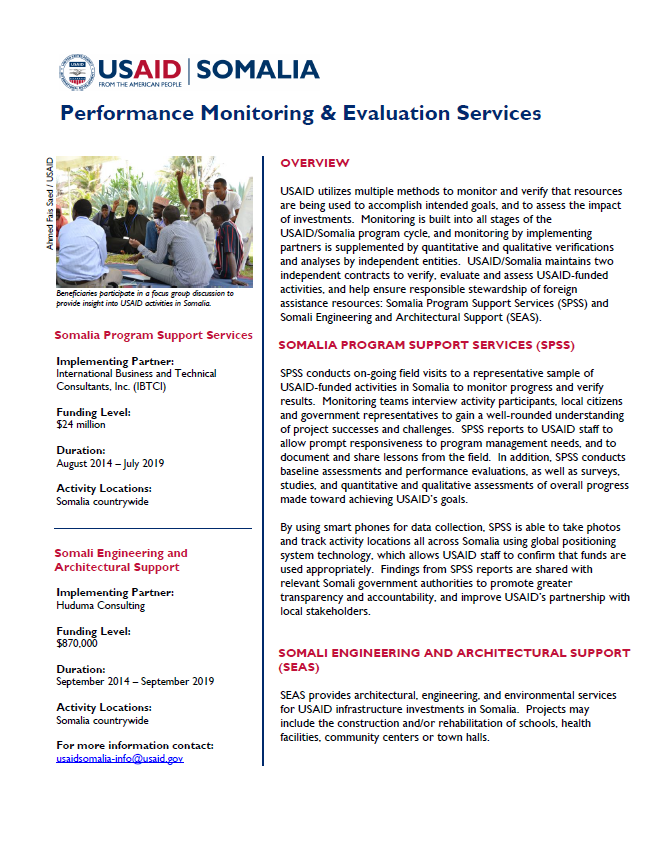OVERVIEW
USAID utilizes multiple methods to monitor and verify that resources are being used to accomplish intended goals, and to assess the impact of investments. Monitoring is built into all stages of the USAID/Somalia program cycle, and monitoring by implementing partners is supplemented by quantitative and qualitative verifications and analyses by independent entities. USAID/Somalia maintains two independent contracts to verify, evaluate and assess USAID-funded activities, and help ensure responsible stewardship of foreign assistance resources: Somalia Program Support Services (SPSS) and Somali Engineering and Architectural Support (SEAS).
SOMALIA PROGRAM SUPPORT SERVICES (SPSS)
SPSS conducts on-going field visits to a representative sample of USAID-funded activities in Somalia to monitor progress and verify results. Monitoring teams interview activity participants, local citizens and government representatives to gain a well-rounded understanding of project successes and challenges. SPSS reports to USAID staff to allow prompt responsiveness to program management needs, and to document and share lessons from the field. In addition, SPSS conducts baseline assessments and performance evaluations, as well as surveys, studies, and quantitative and qualitative assessments of overall progress made toward achieving USAID’s goals.
By using smart phones for data collection, SPSS is able to take photos and track activity locations all across Somalia using global positioning system technology, which allows USAID staff to confirm that funds are used appropriately. Findings from SPSS reports are shared with relevant Somali government authorities to promote greater transparency and accountability, and improve USAID’s partnership with local stakeholders.
SOMALI ENGINEERING AND ARCHITECTURAL SUPPORT (SEAS)
SEAS provides architectural, engineering, and environmental services for USAID infrastructure investments in Somalia. Projects may include the construction and/or rehabilitation of schools, health facilities, community centers or town halls.
SEAS starts its work at the design phase. Engineers begin by reviewing all construction documentation completed by USAIDs implementing partners, including site plans, construction drawings, technical specifications and cost estimates. SEAS ensures that all design and construction documentation is complete and includes where applicable clear structural, electrical and mechanical drawings and specifications appropriate for the project that follow best practices.
It verifies project compliance with USAID environmental standards, along with host government regulations and generally accepted international architectural standards.
Once construction is complete, SEAS staff conduct site visits and reports on the condition of the infrastructure project over time along with its maintenance. SEAS verifies whether contractors have completed construction activities according to the plans, and reports to USAID its findings, including photos and recommendations for USAID to act on with its implementing partners.








Comment
Make a general inquiry or suggest an improvement.